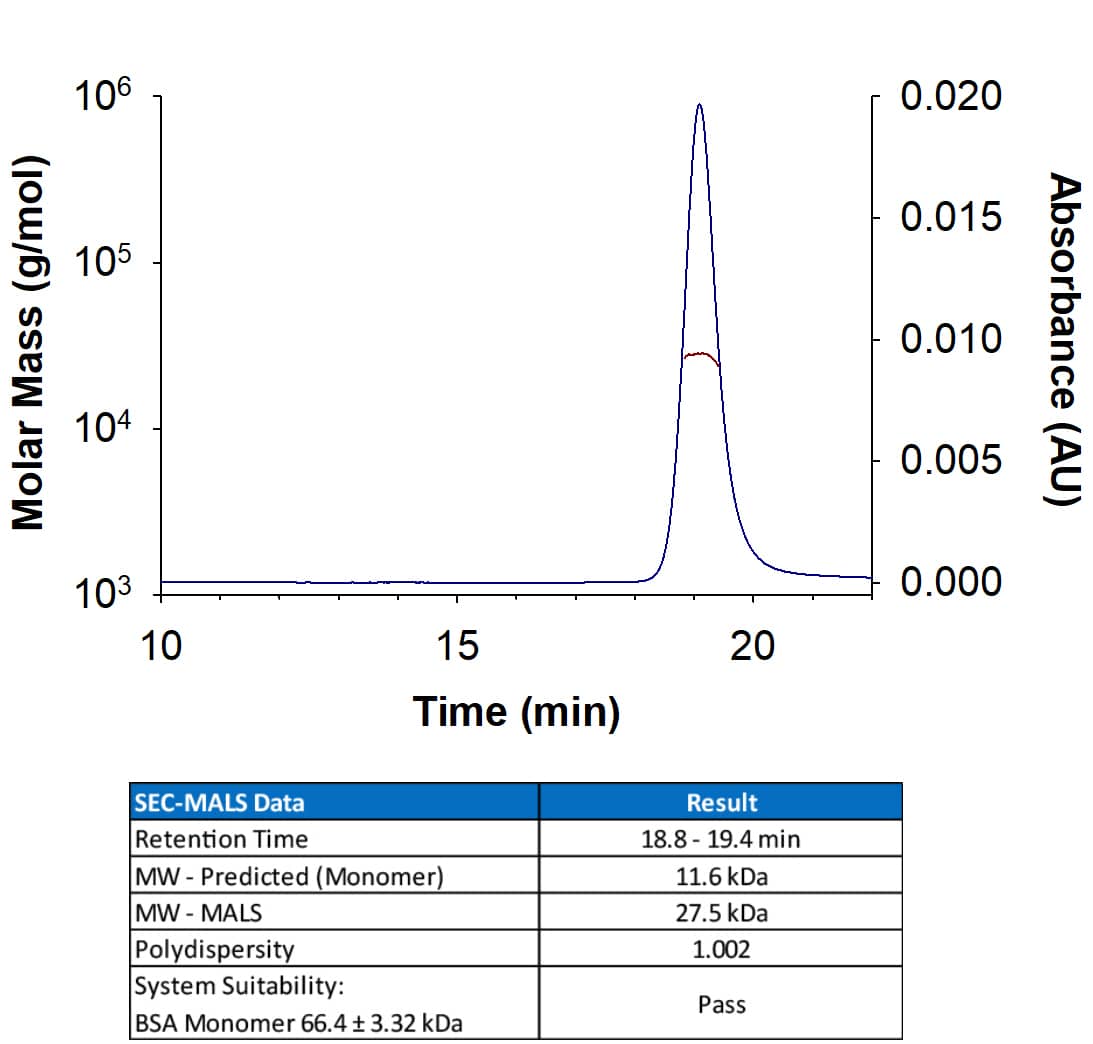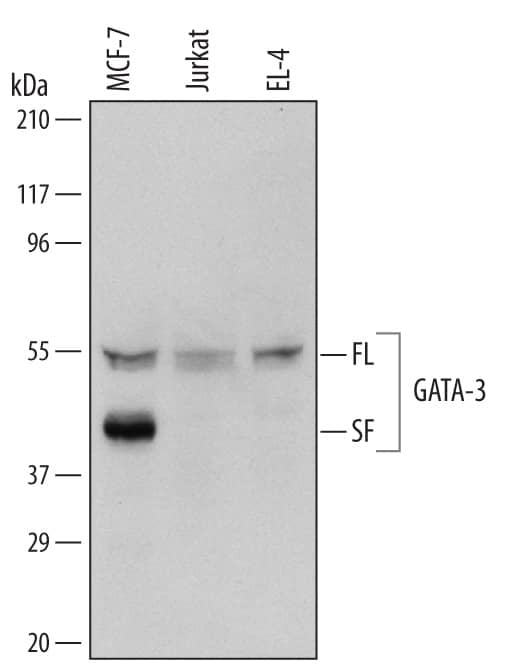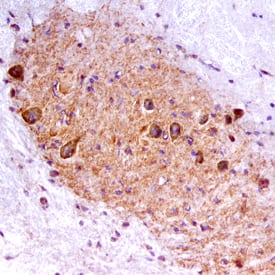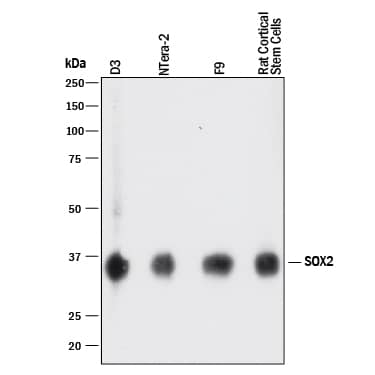Human Ret Antibody Summary
Leu29-Arg635
Accession # P07949
Customers also Viewed
Applications
Please Note: Optimal dilutions should be determined by each laboratory for each application. General Protocols are available in the Technical Information section on our website.
Scientific Data
 View Larger
View Larger
Ret in Human Spinal Cord. Ret was detected in immersion fixed paraffin-embedded sections of human spinal cord using Goat Anti-Human Ret Antigen Affinity-purified Polyclonal Antibody (Catalog # AF1485) at 3 µg/mL for 1 hour at room temperature followed by incubation with the Anti-Goat IgG VisUCyte™ HRP Polymer Antibody (Catalog # VC004). Tissue was stained using DAB (brown) and counterstained with hematoxylin (blue). Specific staining was localized to motor neurons. View our protocol for IHC Staining with VisUCyte HRP Polymer Detection Reagents.
Preparation and Storage
- 12 months from date of receipt, -20 to -70 °C as supplied.
- 1 month, 2 to 8 °C under sterile conditions after reconstitution.
- 6 months, -20 to -70 °C under sterile conditions after reconstitution.
Background: Ret
The GDNF family of neurotrophic factors forms a subfamily within the TGF-beta superfamily. These proteins are potent survival factors for various central and peripheral neurons during development and the adult animal. The GDNF family members (GDNF, neurturin, artemin and persephin) signal through multicomponent receptors that consist of the Ret receptor tyrosine kinase and one of four glycosyl-phosphatidylinositol (GPI)-linked ligand-binding subunits (GFR alpha ‑1‑4). GFR alpha -1, -2, -3, and -4 are the preferred ligand-binding subunits for GDNF, neurturin, artemin and persephin, respectively. The Ret tyrosine-kinase receptor is encoded by the c-ret proto-oncogene. Mutations of the ret gene have been associated with various human diseases affecting tissues derived from the neural crest, including Hirschsprung’s disease, multiple endocrine neoplasia MEN2A and MEN2B, and familial medullary thyroid carcinoma. Human and mouse Ret share 83% amino acid sequence homology (77% homology in the extracellular domain and 93% homology in the cytoplasmic domain). Although Ret does not bind GDNF ligands directly, the extracellular domain of Ret binds the GDNF-GFR-alpha complex with high affinity and is a potent GDNF antagonist in the presence of soluble GFR-alpha (1-4).
- Trupp, M. et al. (1998) Mol. Cell. Neurosci. 11:47.
- Enokido, Y. et al. (1998) Curr. Biol. 8:1019.
- Carlomagno, F. et al. (1998) Endocrinology 139:3613.
- Baloh, R. et al. (1998) Neuron 21:1291.
Product Datasheets
Citations for Human Ret Antibody
R&D Systems personnel manually curate a database that contains references using R&D Systems products. The data collected includes not only links to publications in PubMed, but also provides information about sample types, species, and experimental conditions.
11
Citations: Showing 1 - 10
Filter your results:
Filter by:
-
Emergence of nociceptive functionality and opioid signaling in human induced pluripotent stem cell-derived sensory neurons
Authors: R�derer P, Belu A, Heidrich L et al.
Pain
-
Integrating collecting systems in kidney organoids through fusion of distal nephron to ureteric bud
Authors: Shi, M;Crouse, B;Sundaram, N;Shakked, NP;Ester, L;Zhang, W;Janakiram, V;Kopan, R;Helmrath, MA;Bonventre, JV;McCracken, KW;
bioRxiv : the preprint server for biology
Species: Human
Sample Types: Organoid
Applications: Immunocytochemistry -
Human Nephrogenesis can Persist Beyond 40 Postnatal Days in Preterm Infants
Authors: Carpenter, J;Yarlagadda, S;VandenHeuvel, KA;Ding, L;Schuh, MP;
Kidney international reports
Species: Human
Sample Types: Whole Tissue
Applications: Immunohistochemistry -
Emergence of nociceptive functionality and opioid signaling in human induced pluripotent stem cell-derived sensory neurons
Authors: R�derer P, Belu A, Heidrich L et al.
Pain
-
Bringing to light the physiological and pathological firing patterns of human induced pluripotent stem cell-derived neurons using optical recordings
Authors: TC Alich, P Röderer, B Szalontai, K Golcuk, S Tariq, M Peitz, O Brüstle, I Mody
Frontiers in Cellular Neuroscience, 2023-01-17;16(0):1039957.
Species: Human
Sample Types: Transduced Whole Cells
Applications: ICC -
GDNF signaling in subjects with minimal motor deficits and Parkinson's disease.
Authors: Chu Y, Kordower J
Neurobiol Dis, 2021-03-05;153(0):105298.
Species: Cynomolgus Monkey
Sample Types: Whole Tissue
Applications: IHC -
Expansion of Human iPSC-Derived Ureteric Bud Organoids with Repeated Branching Potential
Authors: SI Mae, M Ryosaka, S Sakamoto, K Matsuse, A Nozaki, M Igami, R Kabai, A Watanabe, K Osafune
Cell Rep, 2020-07-28;32(4):107963.
Species: Human
Sample Types: Organoids
Applications: ICC -
Gut Microbiota Modulate CD8�T Cell Responses to Influence Colitis-Associated Tumorigenesis
Authors: AI Yu, L Zhao, KA Eaton, S Ho, J Chen, S Poe, J Becker, A Gonzalez, D McKinstry, M Hasso, J Mendoza-Ca, J Whitfield, C Koumpouras, PD Schloss, EC Martens, GY Chen
Cell Rep, 2020-04-07;31(1):107471.
Species: Human
Sample Types: Whole Cells
Applications: ICC -
Long-term post-mortem studies following neurturin gene therapy in patients with advanced Parkinson's disease.
Authors: Chu Y, Bartus R, Manfredsson F, Olanow C, Kordower J
Brain, 2020-03-01;143(3):960-975.
Species: Mouse
Sample Types: Whole Tissue
Applications: IHC -
Single-cell analysis of progenitor cell dynamics and lineage specification in the human fetal kidney.
Authors: Menon R, Otto E, Kokoruda A, Zhou J, Zhang Z, Yoon E, Chen Y, Troyanskaya O, Spence J, Kretzler M, Cebrian C
Development, 2018-08-30;145(16):.
Species: Human
Sample Types: Whole Tissue
Applications: IHC -
Functional RET G691S polymorphism in cutaneous malignant melanoma.
Authors: Narita N, Tanemura A, Murali R, Scolyer RA, Huang S, Arigami T, Yanagita S, Chong KK, Thompson JF, Morton DL, Hoon DS
Oncogene, 2009-06-29;28(34):3058-68.
Species: Human
Sample Types: Whole Cells, Whole Tissue
Applications: IHC-P, Neutralization
FAQs
No product specific FAQs exist for this product, however you may
View all Antibody FAQsIsotype Controls
Reconstitution Buffers
Secondary Antibodies
Reviews for Human Ret Antibody
There are currently no reviews for this product. Be the first to review Human Ret Antibody and earn rewards!
Have you used Human Ret Antibody?
Submit a review and receive an Amazon gift card.
$25/€18/£15/$25CAN/¥75 Yuan/¥2500 Yen for a review with an image
$10/€7/£6/$10 CAD/¥70 Yuan/¥1110 Yen for a review without an image



















